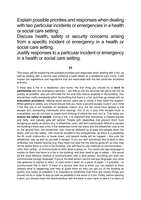Explain possible priorities and responses when dealing
with two particular incidents or emergencies in a health
or social care setting.
Discuss health, safety or security concerns arising
from a specific incident or emergency in a health or
social care setting.
Justify responses to a particular incident or emergency
in a health or social care setting.
P4
This essay will be explaining the possible priorities and responses when dealing with a fire, as
well as dealing with a service user suffering a heart attack at a residential care home. It will
explain the legislations and regulations that are associated with the two particular situations
and why.
If there was a fire in a residential care home, the first thing you should do is work in
partnership with the emergency services – call 999 so the fire services can get to the fire as
quickly as possible, and can eliminate the fire and help rescue anybody in the building. You
should then notify everybody within the building that there is a fire, and then go ahead with an
evacuation procedure, helping assist service users get to safety if they need this support.
While getting to safety, you should ensure that you have a second escape route in your mind
if the first one is not available for whatever reason (e.g. the fire could have spread to the
escape exit, preventing individuals from leaving), this is so if your first escape route is
unavailable, you do not have to waste time thinking of where the next one is. This helps you
ensure the safety of people. During a fire, it is important that everybody is treated equally
and fairly, and nobody gets left behind. People with disabilities that prevent them from
escaping as easily as others (e.g. a wheelchair user), will find it particularly difficult to escape
the building if there was a fire. If the residential home has stairs and the wheelchair user is not
on the ground floor, the wheelchair user must be assisted by at least two people down the
stairs, and out into safety. Lifts must be avoided in fire emergencies, as there is a possibility
the lift could malfunction or break down, and people inside will be trapped – this puts the
wheelchair user as well as yourself in danger. If you are with somebody who is deaf or who
otherwise has trouble hearing (e.g. they might not hear the fire alarms going off, so they may
not be aware there is a fire in the building), you will have to use methods of communication –
other than verbal – to communicate to them what is going on. You could use sign language to
explain to them that there is a fire in the building, and they need to get to safety – this would
be the most effective method of communication with a deaf person, providing you both can
communicate via sign language. If you or the deaf person cannot use sign language, you could
use gestures to explain to them, or even write it down on a piece of paper – if possible – to
communicate this to them. If there is a service user who is blind, you can explain to them
verbally what is happening, and help to guide them so they can get out of the building as
quickly and safely as possible. It is important to remember that there are certain things you
should not do in order to stay as safe as possible in the event of a fire. Firstly, before opening
a door, you should check the doorknob/door with the back of your hand, to see if it is warm or




